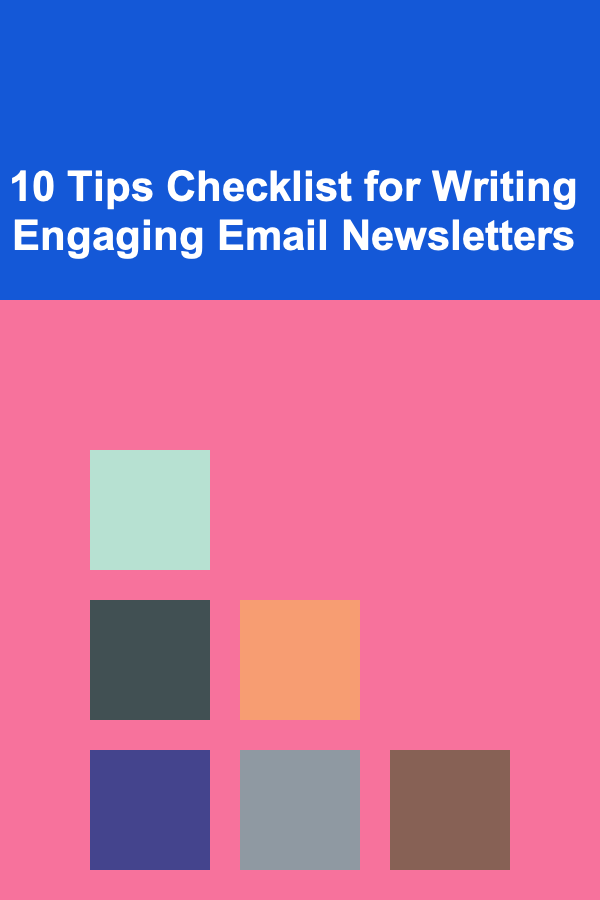
10 Tips Checklist for Writing Engaging Email Newsletters
ebook include PDF & Audio bundle (Micro Guide)
$12.99$10.99
Limited Time Offer! Order within the next:

Email newsletters have evolved from simple updates into powerful tools for communication, marketing, and brand-building. Whether you're a content creator, business owner, or marketer, writing an engaging email newsletter is essential for keeping your audience informed, interested, and coming back for more. However, creating a compelling email newsletter requires more than just tossing together some content. It involves understanding your audience, crafting a message that resonates, and ensuring that every aspect---from the subject line to the call-to-action---contributes to a meaningful interaction.
In this article, we will explore 10 tips that form a checklist to help you create email newsletters that captivate your audience and drive results.
Craft a Captivating Subject Line
The subject line is the first thing your recipients will see, and it plays a crucial role in whether or not they open your email. It's your first opportunity to grab attention, so it's important to make it count.
Key Tips for Writing Effective Subject Lines:
- Be Clear and Concise: Avoid vagueness. Let your audience know exactly what they can expect when they open the email.
- Create Curiosity: Give them just enough information to make them curious about the content inside.
- Personalize: Use the recipient's name or other personalized information when possible. This increases the likelihood that they'll open your email.
- Use Actionable Language: Phrases like "Don't Miss Out," "Get Started Today," or "Discover What's New" can create a sense of urgency or excitement.
Example:
- Instead of "Our Monthly Newsletter," try "Unlock Exclusive Deals and News Inside!"
Segment Your Audience
Not every subscriber is interested in the same thing, so sending the same newsletter to your entire email list can be counterproductive. Segmentation allows you to deliver targeted content to specific groups based on their interests, behaviors, or demographics.
How to Segment Your Audience:
- By Demographics: Age, gender, location, etc.
- By Behavior: Past purchases, website activity, or engagement with previous emails.
- By Engagement Level: New subscribers, frequent readers, or inactive users.
Tailoring content to specific audience segments will increase the relevance of your newsletter and improve engagement rates.
Personalize the Content
People like feeling like they are being spoken to directly. Personalization goes beyond just inserting a name into the subject line. It involves offering content that resonates with the individual.
How to Personalize Your Email:
- Dynamic Content: Use dynamic fields to display content based on user behavior. For instance, a user who clicked on a product category in a previous email could be shown related products in the current email.
- Location-Specific Content: If your business operates in different regions, show region-specific content like promotions or news.
- Behavioral Triggers: Send automated emails based on specific actions a subscriber has taken, such as abandoning a shopping cart or visiting certain pages on your website.
Personalization can help you connect with your audience on a deeper level, making them feel more valued and increasing the chances of engagement.
Make Your Emails Visually Appealing
Your email design is almost as important as the content itself. A well-designed email enhances the reading experience, making your message easier to digest and more aesthetically pleasing.
Design Tips for Engaging Email Newsletters:
- Mobile-Friendly: Ensure your emails are responsive and easy to read on mobile devices. A significant portion of email opens occurs on mobile, and a non-responsive design can lead to poor user experience and high bounce rates.
- Consistent Branding: Use colors, fonts, and logos that are consistent with your brand. This will help build recognition and trust.
- Clear Hierarchy: Use headings, subheadings, bullet points, and whitespace to break up the content. Make sure the most important information stands out.
An attractive email design encourages recipients to engage with your content and can make a lasting impression.
Write Compelling Preheader Text
The preheader text appears next to or below the subject line in the inbox, and it gives subscribers a sneak peek into the content of the email. A strong preheader can convince someone to open your email, especially if the subject line is ambiguous or doesn't fully capture the email's value.
How to Write an Effective Preheader:
- Complement the Subject Line: Your preheader should add context or further intrigue about the email's content.
- Keep It Short: Aim for 35-50 characters, as anything longer might get cut off, especially on mobile devices.
- Include a Call to Action: If appropriate, incorporate a call to action to entice subscribers to open your email.
Example:
- Subject Line: "Exclusive Offer Just for You"
- Preheader Text: "Save 20% on your next purchase---limited time only!"
Focus on Quality Content
Your subscribers are opening your emails because they expect to receive valuable, relevant content. If you send them low-quality, irrelevant, or overly promotional content, they're likely to unsubscribe or stop opening your emails.
Content Tips for Engaging Newsletters:
- Provide Value: Share helpful tips, informative articles, or exciting updates that will benefit your readers.
- Be Concise: People are busy, so get to the point quickly. Keep your content brief and scannable, especially for mobile readers.
- Incorporate Storytelling: Stories create emotional connections with your readers. Whether it's a customer success story, a behind-the-scenes look at your business, or a personal anecdote, storytelling can make your content more engaging.
Example:
If you run a fitness blog, instead of simply listing "fitness tips," try sharing a transformation story with before-and-after photos, as this can inspire your readers to take action.
Use Clear and Persuasive Calls to Action (CTAs)
Your email newsletter should have a clear purpose, and your calls to action (CTAs) should direct your readers toward that goal. Whether you want them to read a blog post, purchase a product, or share your content, a strong CTA can guide them toward taking the desired action.
CTA Tips for Maximum Impact:
- Be Direct: Use action-oriented language like "Shop Now," "Get Started," "Claim Your Offer," or "Learn More."
- Make It Stand Out: Use buttons or contrasting colors to make your CTA easy to spot.
- Limit the Number of CTAs: Too many options can overwhelm the reader. Focus on one or two primary CTAs to guide their actions.
Example:
Instead of simply saying "Click Here," try "Discover Your Perfect Outfit Now" for a more compelling CTA.
Test and Optimize for Better Results
Testing is one of the most important steps in ensuring that your email newsletters perform at their best. Even small changes to subject lines, design, content, and CTAs can make a big difference.
A/B Testing Best Practices:
- Subject Line A/B Test: Test different subject lines to see which ones lead to higher open rates.
- CTA Test: Try different versions of your CTA text, color, and placement to see what drives the most clicks.
- Content Variations: Test different formats for your content, such as long-form articles versus short, digestible snippets.
Use the results from these tests to continuously optimize your email strategy and improve engagement over time.
Ensure Consistency and Frequency
Consistency in your email newsletter schedule is key to building trust with your audience. When subscribers know when to expect your emails, they are more likely to stay engaged.
How to Maintain Consistency:
- Set a Schedule: Whether it's weekly, bi-weekly, or monthly, choose a frequency that you can maintain without overwhelming your audience.
- Content Calendar: Plan your content in advance to ensure that you always have something valuable to share.
- Stay on Brand: Make sure your emails maintain a consistent tone, voice, and design to reinforce your brand identity.
Example:
A weekly "Friday Round-Up" email could feature a curated list of industry news, blog posts, or special promotions, giving your audience something to look forward to each week.
Include Unsubscribe Options and Respect Privacy
While it may seem counterintuitive, providing an easy way for people to unsubscribe is crucial. Not only is it a legal requirement under laws like GDPR, but it also helps you maintain a healthy email list and avoid sending emails to uninterested recipients.
Respect Your Subscribers' Privacy:
- Clear Unsubscribe Option: Make the unsubscribe process simple and visible. Don't bury it at the bottom of the email.
- Privacy Compliance: Ensure you follow privacy regulations such as GDPR, CAN-SPAM, and CCPA, and be transparent about how you collect and use subscriber data.
- Reengagement Campaigns: Before people unsubscribe, you can try to re-engage them with special offers or surveys to understand why they're no longer interested.
Conclusion: Keep Your Audience Engaged and Coming Back
Creating an engaging email newsletter is not an overnight process. It requires understanding your audience, crafting valuable content, and continually optimizing your approach based on feedback and performance. By following this checklist and incorporating the tips provided, you can write email newsletters that not only engage your subscribers but also build lasting relationships and drive long-term success.
Remember, your goal should always be to deliver value to your readers. If you do that, they will stay subscribed, engage with your content, and act on your calls to action.
Reading More From Our Other Websites
- [Metal Stamping Tip 101] The Ultimate Guide to Aluminum Metal Stamping: Techniques, Tools, and Best Practices
- [Home Pet Care 101] How to Keep Your Home Clean and Free from Pet Odors
- [Organization Tip 101] How to Create a Seasonal Shoe Rotation Calendar
- [Home Budget Decorating 101] How to Find Budget-Friendly Furniture That Looks Luxe
- [Polymer Clay Modeling Tip 101] Best Techniques for Achieving Metallic Sheen on Polymer Clay Without Real Metal
- [Home Maintenance 101] Best Ways to Prevent Mold Growth and Maintain a Healthy Living Space
- [Horseback Riding Tip 101] Flexibility Boosters: Stretching Sequences for Riders and Their Horses
- [Organization Tip 101] Top 10 DIY Home Improvement Projects to Boost Your Home's Value
- [Home Maintenance 101] How to Organize Your Home Maintenance Tasks for Maximum Efficiency
- [Home Maintenance 101] How to Perform Regular Plumbing Maintenance to Avoid Leaks

How to Choose the Right Build Volume for Your Projects
Read More
How To Discuss a Movie's Casting Choices
Read More
How to Make Your First Investment in Index Funds
Read More
Staying Motivated During Your Job Search: Tips for Persistence
Read More
How to Choose a Secure Blockchain Wallet
Read MoreHow to Integrate Life Insurance into Your Overall Budget Tracker
Read MoreOther Products

How to Choose the Right Build Volume for Your Projects
Read More
How To Discuss a Movie's Casting Choices
Read More
How to Make Your First Investment in Index Funds
Read More
Staying Motivated During Your Job Search: Tips for Persistence
Read More